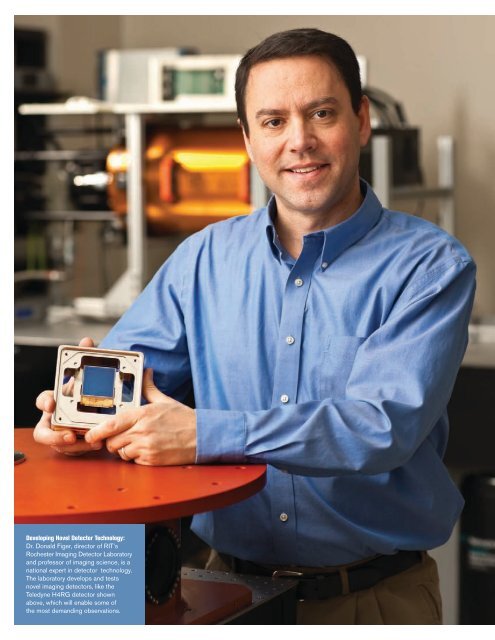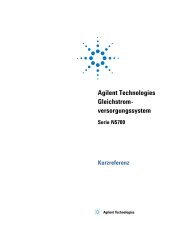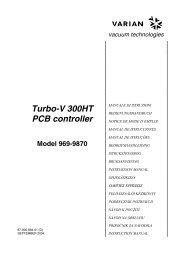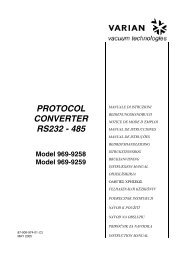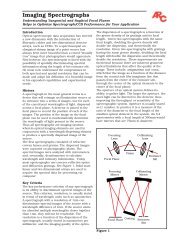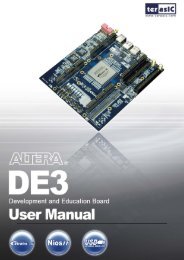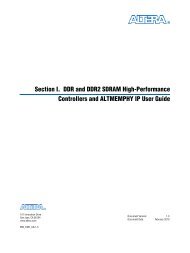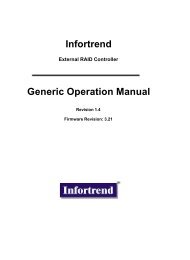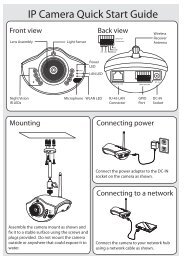Developing Novel Detector Technology: Dr. Donald Figer, director of ...
Developing Novel Detector Technology: Dr. Donald Figer, director of ...
Developing Novel Detector Technology: Dr. Donald Figer, director of ...
You also want an ePaper? Increase the reach of your titles
YUMPU automatically turns print PDFs into web optimized ePapers that Google loves.
<strong>Developing</strong> <strong>Novel</strong> <strong>Detector</strong> <strong>Technology</strong>:<br />
<strong>Dr</strong>. <strong>Donald</strong> <strong>Figer</strong>, <strong>director</strong> <strong>of</strong> RIT’s<br />
Rochester Imaging <strong>Detector</strong> Laboratory<br />
and pr<strong>of</strong>essor <strong>of</strong> imaging science, is a<br />
national expert in detector technology.<br />
The laboratory develops and tests<br />
novel imaging detectors, like the<br />
Teledyne H4RG detector shown<br />
above, which will enable some <strong>of</strong><br />
the most demanding observations.
Advancing Imaging <strong>Detector</strong>s<br />
Advancements in imaging detectors promise to make more discoveries, solve<br />
more problems, cure more people, identify more threats, and manage resources<br />
more effectively.<br />
Rochester Imaging <strong>Detector</strong> Laboratory<br />
Imaging detectors are <strong>of</strong>ten the limiting factor for the most<br />
ambitious observations, across a broad range <strong>of</strong> applications.<br />
Some <strong>of</strong> the most demanding challenges require high-performance<br />
detectors.<br />
Founded in 2006, the Rochester Imaging <strong>Detector</strong> Laboratory<br />
(RIDL) is making significant contributions to design,<br />
develop, and implement advanced sensor technologies. Under<br />
the leadership <strong>of</strong> <strong>Dr</strong>. <strong>Donald</strong> <strong>Figer</strong>, lab <strong>director</strong> and pr<strong>of</strong>essor<br />
<strong>of</strong> imaging science, the lab has established key partnerships<br />
with University <strong>of</strong> Rochester, Lincoln Laboratory at Massachusetts<br />
Institute <strong>of</strong> <strong>Technology</strong> (MIT), Sandia National<br />
Laboratory, the Jet Propulsion Laboratory at California Institute<br />
<strong>of</strong> <strong>Technology</strong> (CalTech), NASA, and other leading<br />
laboratories in an effort to advance imaging sensor technology.<br />
RIDL aims to operate within all ranges <strong>of</strong> the <strong>Technology</strong><br />
Readiness Level (TRL) scale, from initial conceptualization to<br />
successful deployment. TRL was developed by the Department<br />
<strong>of</strong> Defense and is used<br />
System Test, Launch<br />
& Operations<br />
System/Subsystem<br />
Development<br />
<strong>Technology</strong><br />
Demonstration<br />
<strong>Technology</strong><br />
Development<br />
Research to Prove<br />
Feasibility<br />
Basic <strong>Technology</strong><br />
Research<br />
TRL 9<br />
——<br />
TRL 8<br />
——<br />
TRL 7<br />
——<br />
TRL 6<br />
——<br />
TRL 5<br />
——<br />
TRL 4<br />
——<br />
TRL 3<br />
——<br />
TRL 2<br />
——<br />
TRL 1<br />
<strong>Technology</strong> Readiness Level:<br />
The <strong>Technology</strong> Readiness<br />
Level scale was developed by<br />
the Department <strong>of</strong> Defense and<br />
assesses the maturity <strong>of</strong> emerging<br />
technology. RIDL aims to operate<br />
along all levels <strong>of</strong> the scale.<br />
Focus Area | Advancing Imaging <strong>Detector</strong>s<br />
by agencies to assess the<br />
maturity <strong>of</strong> emerging<br />
technologies. At the low<br />
end—one to three—research<br />
is in its initial stages, where<br />
the idea for an invention<br />
begins. On the other end—<br />
six to seven—technology<br />
has been developed and is<br />
being tested in relevant<br />
environments. When an<br />
application is successfully<br />
deployed in its intended<br />
environment, the technology<br />
is said to reach a<br />
TRL <strong>of</strong> nine—full maturity.<br />
“At RIDL, our desire is<br />
not simply to implement<br />
existing hardware, and not<br />
simply to invent crazy ideas,<br />
and not simply to advance<br />
technologies; it is the whole<br />
range,” says <strong>Figer</strong>.<br />
Research at RIT<br />
by Kara Teske<br />
Thirty Meter Telescope: TMT is expected to be among the first extremely<br />
large telescopes to be built over the next 20 years. The novel noiseless<br />
detector being developed at RIDL is expected to effectively quadruple<br />
the collecting power <strong>of</strong> the TMT for the faintest <strong>of</strong> objects in the Universe.<br />
<strong>Novel</strong> Noiseless <strong>Detector</strong><br />
A quantum-limited imaging detector—that is the goal <strong>of</strong> the<br />
project sponsored by The Gordon and Betty Moore Foundation<br />
and in collaboration with Lincoln Laboratory. The novel detector<br />
will be able to detect individual photons, enabling the most<br />
sensitive observations from the world’s largest telescopes,<br />
including the Thirty Meter Telescope (TMT).<br />
TMT is expected to be the first <strong>of</strong> a new generation <strong>of</strong><br />
extremely large telescopes, with a 30-meter diameter segmented<br />
RIDL Facilities: RIDL is equipped with a class 10,000 clean room and class<br />
1,000 flow bench to design and evaluate new detectors.<br />
15<br />
Courtesy <strong>of</strong> TMT Observatory Corporation
Photo credit: Michael Gartley and Don <strong>Figer</strong>.<br />
mirror capable <strong>of</strong> observations from the<br />
near ultraviolet to the mid-infrared. With<br />
the novel noiseless detector, the collecting<br />
power from TMT will be quadrupled for<br />
low-light level applications. Quantumlimited<br />
imaging detectors will also be<br />
useful for ground-based and space-based<br />
astrophysics, Earth and planetary remote<br />
sensing, exo-planet identification,<br />
biomedical imaging, homeland safety, and<br />
even consumer imaging applications.<br />
Regardless <strong>of</strong> the type, noise is <strong>of</strong>ten<br />
the limiting factor among most detectors.<br />
Usually caused by the device itself, noise<br />
16<br />
Focus Area | Advancing Imaging <strong>Detector</strong>s<br />
Importance <strong>of</strong> Read Noise: The images above simulate varying levels <strong>of</strong> read noise in an<br />
image <strong>of</strong> airplanes at Robins Air Force Base. The image on the top left has zero read noise<br />
and the other images have read noise comparable to that found in common usage on<br />
space-based imaging platforms today. These images demonstrate the superior performance<br />
<strong>of</strong> a zero read noise detector.<br />
can restrict the ability to view the image,<br />
especially in low-light conditions. “By<br />
using a digital photon counter to detect<br />
every single photon—or unit <strong>of</strong> light—<br />
our device will have zero read noise,” says<br />
<strong>Figer</strong>. “A detector with zero read noise<br />
will dramatically reduce exposure times<br />
and increase the reach <strong>of</strong> the telescope.”<br />
The design is based on Geiger-Mode<br />
Avalanche Photodiode (GM-APD)<br />
circuitry. The device retains the best properties<br />
found in state-<strong>of</strong>-the-art devices,<br />
while demonstrating a 256x256 silicon<br />
focal plane array. By 2010, the detector is<br />
Spring/Summer 2009 Report<br />
Radiation Tolerant <strong>Detector</strong>: In partnership<br />
with NASA and the University <strong>of</strong> Rochester,<br />
RIDL is developing a detector that is expected<br />
to be resilient against the effects <strong>of</strong> high<br />
energy radiation. In planetary missions,<br />
radiation damage <strong>of</strong>ten limits the capabilities<br />
<strong>of</strong> deployed detectors.<br />
Design for Radiation-Tolerant <strong>Detector</strong>: The device<br />
uses low power complementary metal-oxide<br />
semiconductor (CMOS) multiplexers arranged in<br />
high density.<br />
scheduled to be ready for testing in<br />
relevant environments. “This is a prime<br />
example <strong>of</strong> where we are inventing new<br />
technologies that are advancing the field,”<br />
adds <strong>Figer</strong>.<br />
Radiation-Tolerant <strong>Detector</strong><br />
For decades, we have been exploring<br />
life beyond Earth. The findings <strong>of</strong> these<br />
planetary missions <strong>of</strong>ten depend on<br />
the capability <strong>of</strong> deployed detectors.<br />
The challenge is long before the detectors<br />
reach their destination, the detectors<br />
must travel through harsh radiation
Probing a Test Structure: Matthew Simpson (right),<br />
4 th year biotechnology student, and <strong>Dr</strong>. <strong>Donald</strong><br />
<strong>Figer</strong> (left) work in the clean room probing a test<br />
structure to determine properties <strong>of</strong> the detector,<br />
like dark current levels and breakdown voltage.<br />
environments filled with solar particles,<br />
Galactic cosmic rays, and trapped magnetospheric<br />
plasma. And once they meet<br />
their final destination, even harsher<br />
radiation may await—near Europa and<br />
the Jovian moons, for example.<br />
To maximize the “science return”<br />
<strong>of</strong> future planetary missions, the next<br />
generation <strong>of</strong> imaging detectors need<br />
to be immune to radiation. Through a<br />
project sponsored by NASA, and in partnership<br />
with the University <strong>of</strong> Rochester,<br />
RIDL is developing one such detector.<br />
Current detectors for planetary missions<br />
Focus Area | Advancing Imaging <strong>Detector</strong>s<br />
Journey <strong>of</strong> a Photon<br />
Before high school students embark on<br />
their next life journey—college—Journey<br />
<strong>of</strong> a Photon gives students the opportunity<br />
to explore astronomy and detector science.<br />
The Journey <strong>of</strong> a Photon program is<br />
sponsored by NASA and led by <strong>Dr</strong>. Jacob<br />
Noel-Storr, associate research scientist<br />
at the Center for Imaging Science, and<br />
<strong>Dr</strong>. <strong>Donald</strong> <strong>Figer</strong>, <strong>director</strong> <strong>of</strong> the Rochester<br />
Imaging <strong>Detector</strong> Laboratory. The program<br />
immerses high school students in learning<br />
and communicating science by creating an<br />
interactive planetarium-like experience.<br />
The program fosters relationships among<br />
Research at RIT<br />
View <strong>of</strong> Test Structure: The test structure is an enlarged pixel and is<br />
probed to generate IV curves (electric current and voltage).<br />
students, science teachers, and the local<br />
scientific community. Students interact with<br />
researchers to understand the science issues<br />
involved with the Journey <strong>of</strong> a Photon,<br />
from its creation to its detection. At the<br />
conclusion <strong>of</strong> the program, final projects<br />
will be exhibited this fall at the Rochester<br />
Museum and Science Center to correspond<br />
with the International Year <strong>of</strong> Astronomy and<br />
the Coalition On the Public Understanding<br />
<strong>of</strong> Science (COPUS) Year <strong>of</strong> Science.<br />
“The goal is to engage students so that<br />
they may enter a science discipline when<br />
they head <strong>of</strong>f to college,” adds Noel-Storr.<br />
17
use advance forms <strong>of</strong> the basic Charge-<br />
Coupled Device (CCD) or Complementary<br />
Metal–Oxide–Semiconductor (CMOS)<br />
multiplexers. By taking advantage <strong>of</strong> the<br />
performance approach in CCD and the<br />
low-noise capability <strong>of</strong> the CMOS architecture,<br />
RIDL is merging proven technology<br />
to improve the performance and provide<br />
excellent noise properties <strong>of</strong> CCDs.<br />
The technology <strong>of</strong> the device instantly<br />
converts electromagnetic signals into digital<br />
information, pixel by pixel, eliminating<br />
the ability for radiation to affect the signal.<br />
“With the instant conversion, radiation<br />
doesn’t have time to affect the signal.<br />
Once the data is digitized, it’s nearly<br />
impossible to pick up noise,” notes <strong>Figer</strong>.<br />
To accurately assess the device’s immunity<br />
to radiation, the device will be tested<br />
in three relevant environments, including<br />
the particle beam at UC Davis Crocker<br />
Nuclear Laboratory. When successfully<br />
deployed, the radiation-tolerant detector<br />
will enable greater information gathering<br />
capabilities in future planetary missions.<br />
18<br />
Focus Area | Advancing Imaging <strong>Detector</strong>s<br />
2009 Quantum-Limited Imaging <strong>Detector</strong> Symposium<br />
On March 2-3, 2009, RIT hosted scientists<br />
and researchers from academia, government,<br />
and industry to advance the field <strong>of</strong><br />
quantum-limited imaging detectors. The<br />
realization <strong>of</strong> quantum-limited imaging detectors<br />
would enable the ability <strong>of</strong> some <strong>of</strong><br />
the most demanding measurements.<br />
Experts from a broad range <strong>of</strong> fields<br />
shared critical application needs and new<br />
technology developments that could help to<br />
address those needs. Presenters included<br />
Andrew Berger <strong>of</strong> The Institute <strong>of</strong> Optics at<br />
the University <strong>of</strong> Rochester, Tim Tredwell <strong>of</strong><br />
Carestream Health, Jim Beletic <strong>of</strong> Teledyne<br />
Imaging Sensors, Jeff Puschell <strong>of</strong> Raytheon<br />
Spring/Summer 2009 Report<br />
Space and Airborne Systems, Dan Newman<br />
<strong>of</strong> ITT, and Brian Aull <strong>of</strong> Lincoln Laboratory.<br />
Through collaborative breakout groups,<br />
participants identified key activities to<br />
enable the realization <strong>of</strong> quantum-limited<br />
detectors. “By bringing together such<br />
exceptional talent and experience, we were<br />
able to spark new ideas and create new<br />
opportunities that will bring our field just<br />
another step forward,” add <strong>Dr</strong>. <strong>Donald</strong> <strong>Figer</strong>,<br />
event coordinator.<br />
More information about the event is available<br />
online at http://www.rit.edu/research/<br />
itc/symposium/.<br />
Advancing the Field: Jim Beletic, <strong>director</strong> <strong>of</strong> Astronomy and Civil Space at Teledyne Imaging Sensors, led a session on critical needs and applications<br />
for astrophysics at the Quantum-Limited Imaging <strong>Detector</strong> Symposium hosted at RIT.<br />
A Solution for Sandia<br />
Much <strong>of</strong> RIDL’s research and development<br />
focuses on detector technology,<br />
but the lab is also developing firmware<br />
and s<strong>of</strong>tware applications to support<br />
these technologies.<br />
Daniel Pontillo and John Frye, RIT<br />
computer engineering graduate students,<br />
are working with Sandia National Laboratories<br />
to develop hardware description<br />
language (HDL) s<strong>of</strong>tware that is compatible<br />
with a specific infrared camera.<br />
The research students are investigating<br />
the feasibility <strong>of</strong> customizing a standard<br />
Field Programmable Gate Array (FPGA)<br />
chip to acquire data in a format compatible<br />
with the infrared camera in real-time.<br />
“We have been able to implement a<br />
digital system within the FPGA that<br />
allows us to display the data on the<br />
computer,” says Frye. “The next step<br />
will be to develop the s<strong>of</strong>tware. While<br />
the challenge is rather rudimentary, it<br />
has allowed me to apply my knowledge<br />
<strong>of</strong> detectors and has given me exposure<br />
to a national laboratory. That experience<br />
is unmatched.”<br />
This research will help Sandia evaluate<br />
new sensor technology against critical<br />
mission areas.<br />
Future <strong>of</strong> <strong>Detector</strong>s<br />
In just three years, RIDL has established a<br />
national reputation for helping to advance<br />
detector technology. “The applications are<br />
wide—from making new discoveries<br />
outside our planet to having a better view<br />
<strong>of</strong> the innermost parts <strong>of</strong> the body. It is<br />
our hope the technology we create here<br />
may help to address some <strong>of</strong> the world’s<br />
most pressing challenges,” adds <strong>Figer</strong>.<br />
On the Web<br />
More information about this research<br />
and the Rochester Imaging <strong>Detector</strong><br />
Laboratory is available online.<br />
http://ridl.cis.rit.edu/
Managing Wildfires<br />
RIT imaging scientist <strong>Dr</strong>. Anthony<br />
Vodacek is part <strong>of</strong> a multiuniversity<br />
partnership that<br />
is creating mathematical models<br />
and computer simulations to<br />
better manage and predict<br />
Anthony Vodacek<br />
wildfires. Vodacek, an associate<br />
pr<strong>of</strong>essor in the Center for Imaging Science,<br />
is utilizing imaging technology developed<br />
through RIT’s Wildfire Airborne Sensor<br />
Program (WASP) in the development <strong>of</strong> new<br />
s<strong>of</strong>tware that integrates assimilation algorithms<br />
and sensor data to produce real-time simulations<br />
<strong>of</strong> wildfire movement.<br />
The process collects and analyzes data<br />
on fire development, local weather patterns,<br />
and wind speed to generate better predictive<br />
models on how and where a fire will spread.<br />
Additional s<strong>of</strong>tware is then used to assimilate<br />
model data with geographic and thermal maps<br />
to help fire planners better plan emergency<br />
response and evacuations.<br />
“A wildfire is essentially an atmospheric<br />
phenomenon that interacts with local weather<br />
patterns,” notes Vodacek. “This project is<br />
creating more robust models that will assimilate<br />
what is happening on the ground and in the<br />
atmosphere with how the fire is moving.”<br />
gravitySimulator Tests Einstein’s Theory<br />
Recent advances in technology<br />
have enabled scientists to<br />
observe stars close to the<br />
supermassive black hole at the<br />
center <strong>of</strong> our galaxy, allowing us<br />
David Merritt for the first time ever to truly test<br />
Einstein’s theory <strong>of</strong> relativity.<br />
An excessive amount <strong>of</strong> dust between the<br />
Earth and the center <strong>of</strong> the galaxy makes<br />
observing this region extremely difficult.<br />
High-precision simulations will add the extra<br />
information that scientists need to interpret<br />
features that would otherwise be ambiguous.<br />
Using the gravitySimulator, <strong>Dr</strong>. David Merritt,<br />
pr<strong>of</strong>essor <strong>of</strong> physics, has created a star-by-star<br />
representation <strong>of</strong> the galactic center region.<br />
“We are able to look at a black hole and a<br />
number <strong>of</strong> bordering stars and evolve the<br />
system forward in time, including all the effects<br />
<strong>of</strong> relativity, as we understand it. The simulations<br />
Related Research<br />
Simulation to Predict Wildfire: A false color image <strong>of</strong> a wildfire is processed<br />
to automatically extract the position <strong>of</strong> the active fire line (red<br />
line) and the direction <strong>of</strong> propagation <strong>of</strong> the fire (red arrows) based on<br />
image processing tools.<br />
The technology will also ultimately shed<br />
new light on how large fires affect existing<br />
weather phenomena, such as local wind<br />
patterns, allowing experts to better predict<br />
how wildfires move. The research, which is<br />
allow us for the first time to see how much the<br />
gravitational interactions between stars can<br />
affect the motion compared with relativistic<br />
effects,” says Merritt.<br />
By observing the way stars act on each other<br />
gravitationally, as well as within the black hole,<br />
scientists will be able to test Einstein’s theory.<br />
gravitySimulator is a novel supercomputer<br />
that incorporates special-purpose hardware<br />
to solve the gravitational N-body problem.<br />
Designed by Merritt and <strong>Dr</strong>. Rainer Spurzem,<br />
an astrophysicist at the University <strong>of</strong> Heidelberg,<br />
gravitySimulator is specifically used<br />
to study the dynamical evolution <strong>of</strong> galaxies<br />
and galactic nuclei.<br />
This work is funded through the National<br />
Science Foundation. Merritt works in collaboration<br />
with scientists at Washington University<br />
in St. Louis, Weizmann Institute <strong>of</strong> Science,<br />
University <strong>of</strong> Amsterdam, and the University<br />
<strong>of</strong> Turku.<br />
Research at RIT<br />
funded by the National Science Foundation<br />
and the U.S. Forest Service, also includes<br />
scientists from the University <strong>of</strong> Colorado at<br />
Denver, the University <strong>of</strong> Wyoming, and the<br />
National Center for Atmospheric Research.<br />
gravitySimulator: A novel supercomputer, housed<br />
at RIT, enables researchers to study the dynamic<br />
evolution <strong>of</strong> galaxies and galactic nuclei.<br />
19


